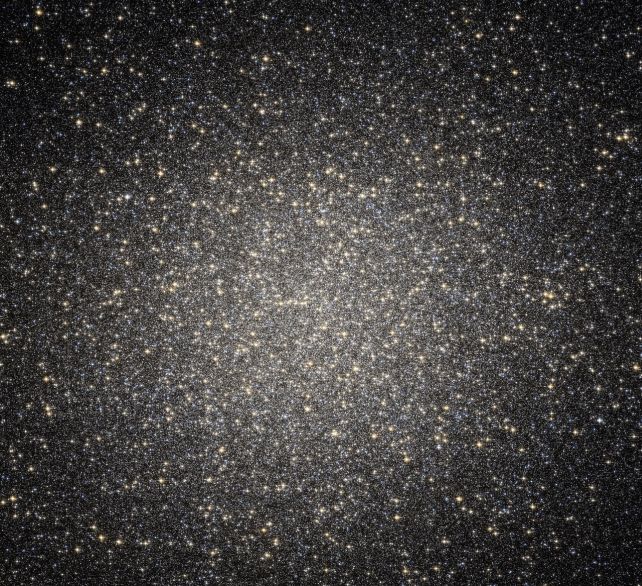Products You May Like
The plot has just thickened in the mystery tale about the unseen mass skulking inside the largest cluster of stars in the Milky Way galaxy.
In the heart of Omega Centauri, a huge glob of gravitationally bound stars over 17,000 light-years away, astronomers have just uncovered evidence of an entire swarm of stellar-mass black holes.
This discovery presents some interesting problems, centered around the fact that previous research suggested the mass was one big black hole, thousands of times the mass of the Sun. But learning the true nature of the darkness that lurks in Omega Centauri brings us closer to solving those problems.
“We have long known about supermassive black holes at galaxy centers and smaller stellar-mass black holes within our own galaxy. However, the idea of intermediate-mass black holes, which could bridge the gap between these extremes, remains unproven,” explains astrophysicist Andrés Bañares Hernández of the Institute of Astrophysics of the Canary Islands in Spain.
“By studying Omega Centauri – a remnant of a dwarf galaxy – we have been able to refine our methods and take a step forward in understanding whether such black holes exist and what role they might play in the evolution of star clusters and galaxies. This work helps resolve a two-decade-long debate and opens new doors for future exploration.”
frameborder=”0″ allow=”accelerometer; autoplay; clipboard-write; encrypted-media; gyroscope; picture-in-picture; web-share” referrerpolicy=”strict-origin-when-cross-origin” allowfullscreen>
Omega Centauri is a globular cluster – a large, dense, spherical glob of stars bound tightly together by gravity. It’s around 150 light-years in diameter, and contains an estimated 10 million stars. It’s thought to be the remnant core of a dwarf galaxy, the Gaia Sausage, that was long ago absorbed into the Milky Way.
Astronomers think that dwarf galaxies may be like full-size galaxies in miniature; rather than a supermassive black hole at its core, with a mass of millions to billions of times that of the Sun, a dwarf galaxy may contain an intermediate-mass black hole, one that is between a hundred and a million Suns.
Intermediate-mass black holes, or IMBHs, are highly sought by astronomers. We think they exist, because there needs to be some kind of link between the stellar-mass black holes that form from dead massive stars, and the supermassive monsters around which galaxies swirl, but we’ve found very little evidence for them.
But black holes, unless they are actively feeding, don’t really give their location away easily. We need to find indirect evidence that they are there. A lot of research has gone into tracking the movements of stars inside Omega Centauri, to see if their motions can be explained by an orbit around an invisible, central mass – a hidden IMBH.

Multiple studies have found that the answer is yes – there does seem to be a hidden mass within Omega Centauri. A paper published earlier this year refined that mass to 8,200 solar masses. Although the mass range for an IMBH hasn’t been officially defined, and astronomers have been known to tweak the definition to fit what they need it to be, 8,200 solar masses is squarely within every IMBH range.
That’s only if, however, that mass is one single object, and not a swarm. Astronomers thought that a swarm would be far less likely, since gravitational interactions between the black holes and other stars could send them flying out of the center of the cluster willy-nilly.
A team led by Bañares Hernández wanted to learn more about the IMBH purported to be hanging out in Omega Centauri, so they added a new dataset into their analysis of the cluster.
They added the accelerations of pulsars into their calculations. Pulsars constitute a subset of neutron stars that rotate very, very fast, many times per second, shooting out beams of radio waves from their poles as they do so. As these beams sweep past Earth, they make the star appear to pulse, like a cosmic lighthouse.
Because the rotational periods of pulsars can be very precisely measured, scientists can use the stars to measure other things, like motion, position, and acceleration, very precisely too. These can be detected in variations in the timing of the pulses.
frameborder=”0″ allow=”accelerometer; autoplay; clipboard-write; encrypted-media; gyroscope; picture-in-picture; web-share” referrerpolicy=”strict-origin-when-cross-origin” allowfullscreen>
According to the team’s modeling and calculations with the added pulsar data, the motions of the stars in the center of Omega Centauri can best be explained by a swarm of small, stellar-mass black holes – those that form from the collapsed cores of massive stars when they die.
But it’s not entirely a nail in a coffin for the presence of an IMBH, either. It’s possible that stellar-mass and intermediate-mass black holes are coexisting. In fact, it could even solve some of the problems of finding a swarm.
The stellar-mass black holes could be bound, just like other stars, by the gravity of the IMBH. And if IMBHs form from hierarchical mergers of stellar-mass black holes, finding both together might be a clue about how giant black holes grow.
“The hunt for elusive intermediate-mass black holes continues. There could still be one at the center of Omega Centauri, but our work suggests that it must be less than about 6,000 times the mass of the Sun and live alongside a cluster of stellar mass black holes,” says astrophysicist Justin Read of the University of Surrey in the UK.
“There is, however, every chance of us finding one soon. More and more pulsar accelerations are coming, allowing us to peer into the centers of dense star clusters and hunt for black holes more precisely than ever before.”
The research is forthcoming in Astronomy & Astrophysics.
